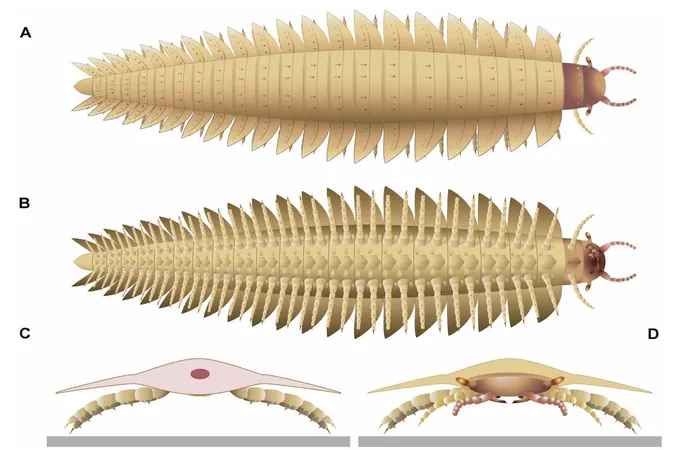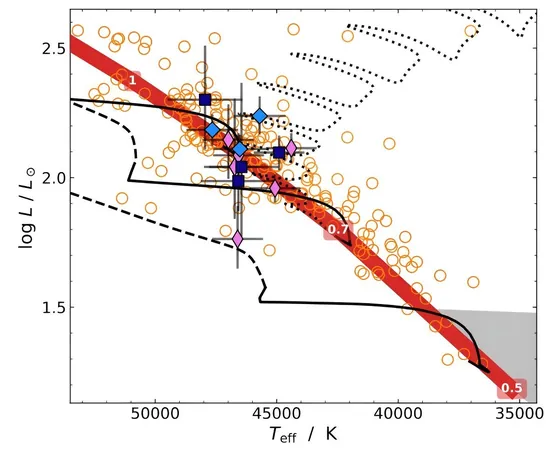
Scientists Unravel the Chilling Features of the Car-Sized Millipede That Stalked Ancient Earth!
2024-10-10
Author: Michael
Introduction
Over 346 million years ago, long before dinosaurs ruled the planet, there existed a fearsome creature that could make anyone think twice about stepping outside. Imagine a millipede larger than a car and weighing over 100 pounds (45 kilograms)! Meet Arthropleura, the largest known arthropod that ever roamed the Earth, sending shivers down the spine of anyone who dared to envision it.
The Enigma of Arthropleura
Despite its enormous size of 8.5 feet (2.6 meters), Arthropleura became extinct roughly 50 million years after it first appeared. Today, however, the fascination with this prehistoric behemoth lingers, especially among paleobiologists who seek to unravel its mysterious lineage. The challenge lies in determining how closely related Arthropleura truly is to the modest-sized millipedes and centipedes we see today.
Classification and Confusion
Originally classified as myriapods, Arthropleura's exact place on the evolutionary tree has puzzled scientists for years. Until recently, the fossil record has remained frustratingly incomplete, lacking any substantial remains of its head—an unfortunate reality since researchers have often misidentified parts of its anatomy, mistaking its neck-like collum for its head. This confusion has made it nearly impossible to gauge its resemblance to the modern multi-legged creatures scuttling around our gardens.
Breakthrough Research
To tackle this enigma, a team led by Mickaël Lhéritier from Université Claude Bernard employed sophisticated tomographic imaging techniques on several well-preserved juvenile fossils. Their groundbreaking research, published in the journal Science Advances, painted an astonishing picture of Arthropleura's features—showing that certain facial characteristics have been inherited by modern-day relatives.
Evolutionary Links and Dietary Habits
The scans revealed that Arthropleura sported seven-segmented antennae similar to millipedes. Intriguingly, it also boasted traits akin to centipedes, including encapsulated mandibles and leg-like jaw structures known as maxillae. This newfound knowledge suggests that millipedes and centipedes share a more recent common ancestor than previously believed, uniting them within a closer family tree.
With this enhanced understanding of Arthropleura's appearance, scientists speculate its dietary habits as well, hypothesizing that it likely scavenged on dead animals—evidence of its role in the ancient ecosystem. However, despite this wealth of information, there remains a shadow of mystery. James Lamsdell, an associate professor of paleobiology at West Virginia University, noted in an accompanying article that essential details about Arthropleura's life remain elusive.
Lingering Mysteries
The creature's precise diet—besides scavenging—and its respiratory mechanisms continue to baffle researchers. Lamsdell even posited that Arthropleura may have experienced various life stages in differing environments, including potentially aquatic habitats.
Conclusion
So, the next time you encounter a harmless millipede in your home, spare a moment to ponder its gigantic ancestor that once roamed the Earth as a terrifying titan. From ancient nocturnal scavengers to today’s tiny versions, the evolution of these creatures tells a fascinating tale of survival and adaptation in the natural world. Let's celebrate the smaller wonders of life and be grateful that they remain diminutive—because imagine the chaos if Arthropleura decided to pay us another visit!









 Brasil (PT)
Brasil (PT)
 Canada (EN)
Canada (EN)
 Chile (ES)
Chile (ES)
 España (ES)
España (ES)
 France (FR)
France (FR)
 Hong Kong (EN)
Hong Kong (EN)
 Italia (IT)
Italia (IT)
 日本 (JA)
日本 (JA)
 Magyarország (HU)
Magyarország (HU)
 Norge (NO)
Norge (NO)
 Polska (PL)
Polska (PL)
 Schweiz (DE)
Schweiz (DE)
 Singapore (EN)
Singapore (EN)
 Sverige (SV)
Sverige (SV)
 Suomi (FI)
Suomi (FI)
 Türkiye (TR)
Türkiye (TR)